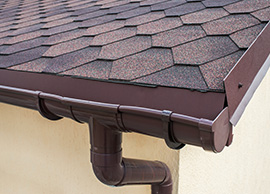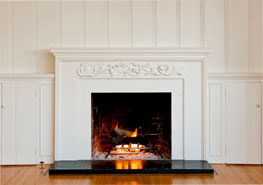Why Insulate?
It’s all about being comfortable in your home. And insulation products offer a variety of easy, cost-effective ways to achieve that goal. When your home stays cooler in the summer and warmer in the winter, your HVAC system runs more efficiently and can last longer. You’ll save money, use less energy and add value to your home.
So whether you’re adding an addition to your home or just looking to increase energy efficiency and comfort, insulation products provide numerous benefits:
- Help regulate indoor temperatures year-round
- Reduce heating and cooling bills
- Increase operating efficiency for your HVAC system
- Reduce unwanted inside and outside noise
- Improve indoor air quality by preventing mold, moisture and allergens from getting inside your home
- Add fire protection*
- Lasts the life of your home
- Add value to your home
Not quite sure where to start? Start with some of the basic questions below to help you figure out the differences between certain insulation types and learn how to pick out the right insulation for your project.
Which Insulation Do I Need?
The type of insulation you need depends on where it will be installed, what R-values are required and your budget. Where you live Formaldehyde-Free™ Fiber Glass Batts and Rolls: available in different thicknesses, R-values and widths to accommodate standard-size walls, crawl spaces, attics and more. Additionally, our different product offerings help make installation easier. Fiber glass insulation is available in many different forms, including rolls and pre-cut batts to fit all standard and non-standard wall cavities. Fiber glass comes in a variety of R-values for different applications throughout your home. Before you begin an insulation project, you should verify the size of your wall cavities (generally 16” or 24”) and attic space to calculate how much insulation you will need.
- Blow-in Loose Fiber Glass: Typically used in unfinished attics, nonconforming spaces and hard-to-reach areas such as corners, edges and around framing. Requires a blowing machine for installation.
- Spray Foam: This alternative to fiber glass is most commonly used in new construction. It is applied using a specific spray applicator―resulting in a thermal, air and moisture barrier. Spray Foam provides a variety of closed-cell and open-cell spray foam solutions to meet specific building and climate needs.
- Mineral Wool: Specifically designed to deliver robust sound dampening, exceptional fire resistance and superior temperature control, it is most commonly installed in wood-stud cavities of interior and exterior walls, basements, ceilings, floors and crawl spaces.
- Foam Sheathing: Rigid-foam-sheathing insulation for use in commercial and residential construction where continuous insulation and/or high thermal efficiency is required. Sheathing provides sheathing solutions for both interior and exterior applications.
What Is R-Value?
R stands for resistance to heat flow. The higher the R-value, the greater the insulating power and resistance to heat flow. Depending on where you live and what area of your home you are insulating, different R-values are recommended. For example, a colder climate requires higher R-values than a milder, more temperate one. R-values may be added together for increased thermal resistance.
What R-Value Do I Need?
Depending on where you live and the part of your home you’re insulating (walls, crawl space, attic, etc.), you’ll need a different R-value. Typical recommendations for exterior walls are R-13 to R-23, while R-30, R-38 and R-49 are common for ceilings and attic spaces. See the Department of Energy’s (DOE) ranges for recommended levels of insulation below.
| Area of Home | Good | Better | Best |
|---|---|---|---|
| Attics | R-30 | R-38 | R-49 |
| Cathedral Ceilings | R-19 | R-30 | R-38 |
| 2×4 Walls | R-13 | R-15 | |
| 2×6 Walls | R-19 | R-21 | |
| Floors | R-19 | R-25 | R-30 |
| Crawl Spaces | R-19 | R-25 | R-30 |
| Basement Walls | R-11 | R-13 | R-15 |
Where Should I Insulate?
Ideally, you should insulate your entire home — from the attic to the crawl space and everything in between. Proper insulation and air sealing can dramatically improve the energy efficiency and comfort of your home. Common insulation projects include attics, crawl spaces, exterior and interior walls, basements and ceilings.
How Much Insulation Do I Need?
The amount of insulation needed depends on the type of insulation you’re using, the R-value you want to achieve, and the size of the space you’re insulating.
How Can I Reduce the Moisture in My Home?
Using insulation with a vapor retarder or adding one to existing insulation helps keep the moisture inside your home from escaping and condensing in insulated cavities, which can cause mold and mildew. Check your local building codes for vapor retarder requirements.
What is the difference between unfaced and Kraft-faced?
Unfaced means the insulation lacks a vapor retarder (paper or plastic facing). Kraft-faced insulation includes a paper vapor retarder, which helps prevent mold and mildew. Check your local building codes for vapor retarder requirements.
What type of equipment do I need?
The right tools and equipment make your insulation project go faster, smoother and more safely. Refer to this checklist to make sure you have everything you need before getting started.
- Tape measure for measuring the insulation and the area being insulated
- Straightedge such as a yardstick or 2×4 for cutting insulation
- Utility knife for cutting insulation
- Stapling tool for attaching faced insulation or polyethylene vapor barrier to framing or studs
- Putty knife or screwdriver for forcing pieces of insulation into small places
- Caulking gun and caulk to seal floor and ceiling plates and other gaps through which air may flow
- Disposable dust mask to help minimize temporary irritation from breathing airborne particles of insulation, sawdust or other materials
- Safety glasses or goggles to protect eyes from airborne particles and other potential hazards
- Loose-fitting, long-sleeved shirt; long pants; and gloves to help minimize skin contact with insulation and insulation dust
- Sturdy work boots for protection from insulation dust and equipment hazards
- Work helmet to protect your head from joists, trusses and other obstructions
- Insulation blower machine for blow-in, loose-fill fiber glass
Do I need a vapor retarder?
Vapor Retarders are typically recommended for the interior side (i.e., the “warm in winter” side) of above-ground framed walls in your home such as bedrooms, bathrooms, garages and attics. A vapor retarder is not required for basement walls, walls made of materials that can’t be damaged by moisture or freezing, or any parts of walls that are below ground.
What is formaldehyde?
Formaldehyde is a chemical compound used in many adhesives for plywood, particle board and other building materials, including some insulation. It is important to limit exposure to formaldehyde because of its potential hazards. We offer a complete line of certified Formaldehyde-free™ fiber glass insulation.
What is facing?
A material — either Kraft paper or plastic — is attached to the fiber glass insulation to help control moisture, mold and draft. Facing can also be applied separately from the insulation. Some fiber glass insulation comes with Kraft (paper) facing as well as plastic-encapsulated facing.




